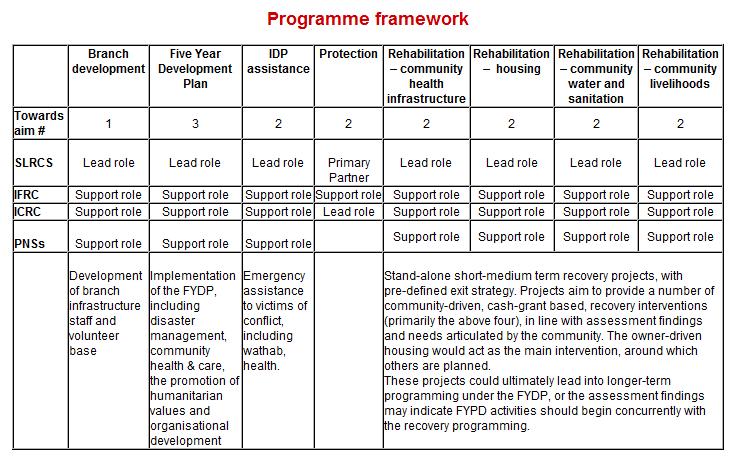Principles and modalities for support to IDPs and returnees
The actions of the Red Cross Movement under this programmatic framework will be rooted in the Seven Fundamental Principles. However, the context of northern Sri Lanka presents some particular challenges to the principled basis of RCM actions. Therefore it is necessary to articulate and reconfirm some principles and modalities in order that they be context-specific:
Movement partners will require access to beneficiaries and authorities in order to initiate assessments and implement project activities with access through the whole project cycle to a standard satisfactory to the implementing partner(s) including donors with due diligence towards accountability and consistent with agreed Movement modalities and principles. Such Movement partners’ access to beneficiaries and authorities will be together with SLRCS, ICRC may approach beneficiaries and authorities directly.
The restriction of one or more components of the Movement’s access is not in itself a legitimate reason for other Movement partners to discontinue or reduce their planned or ongoing operations. However, it is noted that restrictions in access for a Movement partner may hinder the extent to which they can fulfil their function in support of other partners, or their lead role responsibilities. If access is restricted for one or more partner the Movement will seek to limit the impact of this restriction by taking the following actions: (i) Firstly and preferably, collaboratively provide the required capacity from amongst those partners who have access; (ii) alternatively, adapt programming so that the (verifiable) output can be achieved in another way; (iii) if other options have not succeeded, only then reduce the services provided to beneficiaries.
Any activity/program should “support the safe, voluntary and dignified return, relocation or local integration of IDPs” (Movement Policy on Internal Displacement, Resolution 11, article iv.) In particular in the reconstruction of homes and activities aimed at securing sustainable wellbeing will be supported at a location the beneficiary is satisfied with and willingly intends to make their permanent residence. In the case of construction activities, careful consideration will be given to issues of land ownership title and building consent.
Movement partners will conduct project activities in areas that have been cleared of explosive remnants of war. Specifically, Movement partners will avoid providing an incentive through their project activities for beneficiaries to expose themselves to ERW risk.
Movement partners will conduct activities for beneficiaries provided that they have sufficient freedom of movement (on land and/or sea) to provide themselves with a sustainable income.
Detailed project plans and beneficiary eligibility will be based on a prior independent assessment of needs by one or more Movement partners.
Movement partners will not undertake activities that will lend permanency to the IDP camps/facilities, or contribute directly to the perpetuating of the displaced status of IDPs (e.g. providing infrastructure in camps). However, Movement partners will balance this approach with due consideration to the humanitarian needs of the residual IDP population.
Movement Partners with lead role responsibilities (ICRC in Protection; SLRCS in all other areas defined in the enclosed Programme Framework) will undertake operations in agreement with GoSL, and coordinate activities primarily with GoSL. Movement partners will coordinate activities with other humanitarian actors too with the interest of harmonising programmes but reaffirm Movement partners’ independence in operational decision making.
Aims of the programme
The overall aims of the operation are:
1.To re-establish the Kilinochchi and Mulativu branches of SLRCS.
2.To support the return, resettlement and recovery of the population that was displaced by the conflict and, where necessary, to provide temporary humanitarian support for those still displaced.
3.To develop and implement initial programming in line with the SLRCS Five Year Development Plan in areas directly affected by the conflict.
Target population and area
This programme is primarily in support of people who have been displaced due to the conflict in Sri Lanka and are either still displaced or in the process of resettlement. Secondarily, the programme can provide support to host communities or those who have been displaced for longer periods, as is considered necessary on the grounds of equity or conflict sensitivity vis-à-vis the primary beneficiary group.
The basis of primary target population for the programme will be Kilinochchi, Mulativu, and Mannar districts, as well as conflict-affected areas of Vavuniya, Trincomalee, Jaffna, Anuradhapura and Pollonnaruwa districts. Furthermore, it is acknowledged some of those displaced are either displaced to, or intend to return to, the other areas in Sri Lanka, and therefore these populations too could be considered for support under this programme.

Notes:
¹ In accordance with the Status Agreement between GoSL and ICRC entered into on 16th July 1990
² Adopted at the Council of Delegates, Nairobi, November 2009.